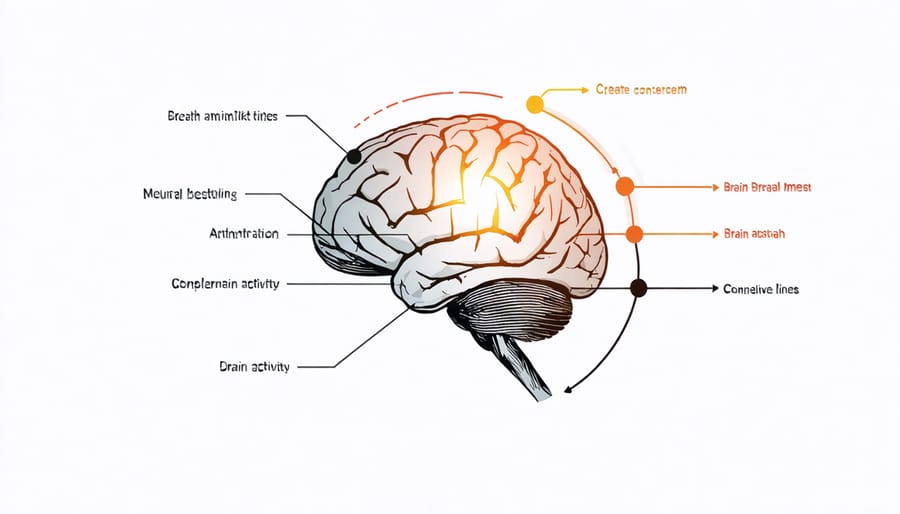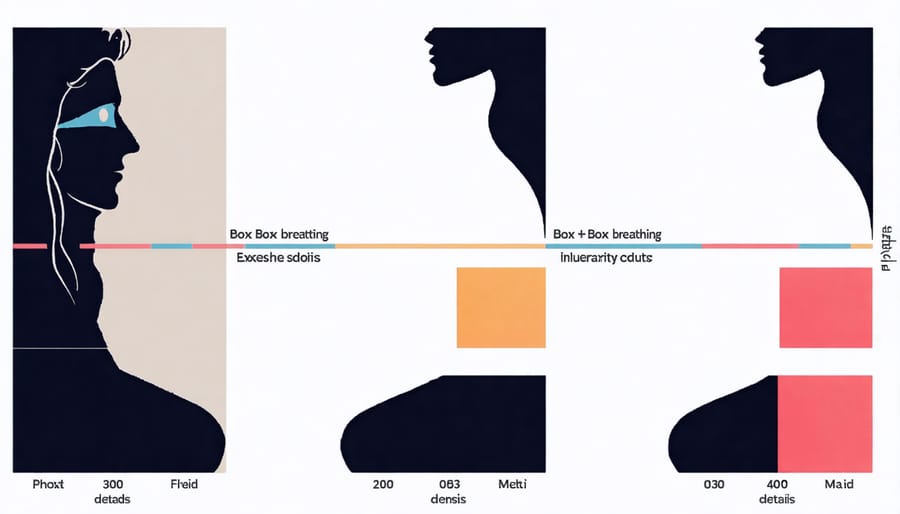Transform your mental and physical wellbeing through the ancient practice of breathwork meditation – a powerful technique that combines focused breathing exercises to calm your mind with deep meditative awareness. Research shows that just 10 minutes of conscious breathing can lower stress hormones, reduce blood pressure, and activate your body’s natural relaxation response.
Unlike traditional meditation, breathwork offers immediate, tangible results you can feel from your very first session. By learning to control your breath, you gain a practical tool for managing anxiety, improving focus, and enhancing overall mental clarity. Whether you’re a busy professional seeking stress relief or someone looking to deepen their mindfulness practice, breathwork meditation provides a scientifically-proven pathway to better health and emotional balance.
This guide will walk you through essential breathwork techniques, backed by current research and expert insights, to help you establish an effective daily practice.
The Science Behind Breathwork and Mental Wellness
Your Brain on Breath
When you practice breathwork meditation, your brain undergoes remarkable changes. Deep, controlled breathing activates your parasympathetic nervous system, often called your “rest and digest” mode. This triggers a reduction in stress hormones like cortisol while increasing the production of feel-good chemicals such as serotonin and dopamine.
Brain imaging studies show that regular breathwork practice can strengthen areas associated with attention and emotional regulation, particularly the prefrontal cortex. Your heart rate variability also improves, indicating better stress resilience and emotional balance.
The slow, rhythmic breathing patterns used in meditation help synchronize neural activity across different brain regions. This synchronization is similar to what happens during states of deep relaxation and meditation, promoting mental clarity and reduced anxiety.
Most notably, consistent breathwork practice can actually change your brain’s structure over time, increasing grey matter density in areas responsible for self-awareness, compassion, and stress management.

Stress Response and Breathing
When you practice controlled breathing, you activate your body’s natural relaxation response. Deep, mindful breaths signal your nervous system to lower cortisol and adrenaline levels, the primary stress hormones that can leave you feeling anxious and overwhelmed. This biological process is crucial for managing stress response effectively.
Research shows that slow, deliberate breathing increases heart rate variability, a key indicator of stress resilience. It also stimulates the vagus nerve, which helps shift your body from a “fight-or-flight” state to a calmer “rest-and-digest” mode. Within just a few minutes of conscious breathing, you may notice your heart rate slowing down, muscles relaxing, and thoughts becoming clearer.
Regular breathwork practice can help build long-term stress resilience, making you less reactive to daily pressures and better equipped to handle challenging situations when they arise.
Essential Breathwork Techniques for Beginners
Box Breathing
Box breathing, also known as square breathing, is a powerful technique used by military personnel, first responders, and stress management experts. This simple yet effective method follows a 4-4-4-4 pattern that helps calm your nervous system and improve focus.
To practice box breathing, find a comfortable seated position in a quiet space. Begin by slowly exhaling all the air from your lungs. Then, follow these four steps:
1. Inhale slowly through your nose while counting to four.
2. Hold your breath for a count of four.
3. Exhale completely through your mouth for a count of four.
4. Hold your breath again for a count of four.
Repeat this cycle for 3-5 minutes or until you feel centered. If counting to four feels too long or short, adjust the count to match your comfort level while maintaining equal timing for all four phases.
For beginners, it’s normal to feel slightly uncomfortable at first. Start with just a few cycles and gradually increase as you become more comfortable with the technique. Practice box breathing daily, particularly during stressful situations or before important events, to experience its full benefits.

Diaphragmatic Breathing
Diaphragmatic breathing, also known as belly breathing, forms the foundation of effective breathwork meditation. Start by finding a comfortable position, either lying down or sitting with your back straight. Place one hand on your chest and the other on your belly, just below your rib cage.
Take a slow, deep breath through your nose, allowing your belly to expand like a balloon. You should feel the hand on your stomach rise while the hand on your chest remains relatively still. This indicates that you’re properly engaging your diaphragm.
Exhale slowly through slightly pursed lips, feeling your belly fall. The hand on your stomach should lower as you release the breath. Aim to make your exhale longer than your inhale – try counting to four as you breathe in and six as you breathe out.
Practice this breathing pattern for 5-10 minutes daily, gradually increasing the duration as you become more comfortable. Remember, the movement should feel natural and relaxed, without forcing or straining.
Alternate Nostril Breathing
Find a comfortable seated position and rest your right thumb against your right nostril. Place your ring finger near your left nostril. Begin by closing your right nostril with your thumb and inhaling slowly through your left nostril for a count of four. Pause briefly, then close your left nostril with your ring finger while releasing your thumb to exhale through your right nostril.
Now, inhale through your right nostril, pause, then close it and exhale through your left. This completes one full cycle. Continue alternating sides for 5-10 minutes, keeping your breath smooth and steady. If you feel lightheaded, return to normal breathing.
This ancient technique, also known as Nadi Shodhana, helps balance the left and right hemispheres of your brain, reduce stress, and improve focus. Practice this breath work when you’re feeling anxious or need to center yourself before important tasks.
Creating Your Daily Breathwork Practice
Setting Up Your Practice Space
Creating a peaceful environment is essential for an effective mindful meditation practice. Choose a quiet room or space where you won’t be disturbed for at least 15-20 minutes. Ensure the temperature is comfortable, typically between 20-22°C (68-72°F), as extreme temperatures can be distracting.
Consider using dim lighting or natural light, and remove any potential distractions like phones or other electronic devices. A supportive cushion or meditation pillow can help maintain proper posture, but a comfortable chair will also work well. Some people find it helpful to create a dedicated meditation corner with meaningful objects like plants, crystals, or calming artwork.
Fresh air is important, so open a window if weather permits or use an air purifier to maintain good air quality. You might want to keep a light blanket nearby, as body temperature can drop during extended breathing exercises. While not essential, gentle background sounds like white noise or nature sounds can help mask unexpected environmental noises and enhance your focus.

Timing and Duration
For optimal results, practice breathwork meditation at consistent times each day. Many people find early morning, before breakfast, to be ideal as the mind is clear and the day’s stresses haven’t yet accumulated. However, you can also practice before bed to help wind down, or during a mid-afternoon break to reset your energy.
Start with 5-10 minutes per session if you’re new to the practice. As you become more comfortable, gradually extend your sessions to 15-20 minutes. Listen to your body and don’t force yourself to practice longer than feels comfortable.
For beginners, aim to practice three times per week. Once you’re established in your routine, try to incorporate daily sessions. If time is limited, even 3-5 minutes of focused breathing can provide benefits. The key is consistency rather than duration.
Remember that breathwork can be energizing, so evening sessions should focus on calming techniques. If you feel lightheaded at any point, return to normal breathing and reduce your session length next time.
Some people find it helpful to set a gentle timer, allowing them to focus fully on their breath without watching the clock.
Common Challenges and Solutions
Troubleshooting Your Practice
If you’re experiencing difficulty maintaining focus during breathwork, start with shorter sessions of 3-5 minutes and gradually increase duration as your practice develops. For those who feel anxious or lightheaded, try reducing the intensity of your breathing or return to normal breathing until you feel comfortable.
Finding it hard to breathe deeply? Practice in a seated position with good posture, keeping your spine straight and shoulders relaxed. If you notice your mind wandering frequently, gently acknowledge the thoughts and return your attention to your breath without self-judgment.
Some practitioners experience dry mouth or throat irritation. Keep water nearby and consider practicing in a well-humidified room. If you feel sleepy during sessions, try practicing at different times of day when you’re naturally more alert, or open your eyes slightly while maintaining your breath focus.
Remember that challenges are normal and part of the learning process. With consistent practice, most difficulties resolve naturally over time.
When to Seek Professional Guidance
While breathwork meditation is generally safe, certain situations warrant professional guidance. If you have respiratory conditions like asthma, cardiovascular issues, or high blood pressure, consult your healthcare provider before starting a practice. Seek professional support if you experience anxiety, panic attacks, or trauma, as intense breathing exercises can sometimes trigger emotional responses.
Consider working with a certified breathwork instructor if you’re new to the practice and want to ensure proper technique, or if you’re interested in advanced breathing methods. This is particularly important for practices like Holotropic Breathwork or Wim Hof Method, which require specialized training.
Watch for warning signs during practice, such as dizziness, numbness, or unusual physical sensations. If you experience persistent discomfort or emotional distress during or after sessions, pause your practice and seek guidance from a qualified instructor or healthcare professional.
Pregnant individuals should always consult their healthcare provider before beginning any new breathing practice.
Breathwork meditation is a powerful tool that can transform your physical and mental well-being when practiced regularly. As we’ve explored throughout this guide, this ancient practice offers numerous benefits, from reduced stress and anxiety to improved focus and emotional balance. The beauty of breathwork lies in its simplicity and accessibility – you don’t need special equipment or a dedicated space to get started.
Remember to begin with basic techniques like box breathing or diaphragmatic breathing before progressing to more advanced practices. Start with just a few minutes daily, gradually increasing the duration as you become more comfortable. Listen to your body and adjust the pace and intensity of your practice accordingly.
Whether you’re seeking stress relief, better sleep, or enhanced overall wellness, breathwork meditation can be your faithful companion on the journey to better health. Don’t be discouraged if you find it challenging at first – like any skill, it takes time and patience to develop.
Take the first step today by incorporating one simple breathing exercise into your daily routine. Your mind and body will thank you for this investment in your well-being.

